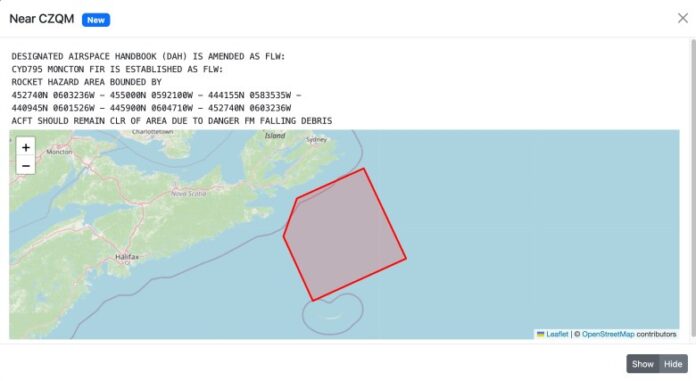The first rocket launch to reach the edge of space from Canada since 1998 could happen as soon as November 18 from Spaceport Nova Scotia for a Dutch rocket built by T-Minus Engineering.
A Notice to airmen (NOTAM) has been issued for the launch of the T-Minus Engineering suborbital launch of its Barracuda hypersonic test platform. The launch window opens November 18 daily through November 24 between 10:00 – 14:00 UTC.
The only other launch to date from Spaceport Nova Scotia was a university launch by York University in July 2023 which reached 13.4 kilometres.
The last attempt to reach space from Canada was in August by Space Concordia when they launched Star Sailor suborbital rocket in attempt to reach the edge of space. While the rocket launched, a feat in of itself, it did not come close.
The T-Minus Engineering Barracuda hypersonic test platform “is a single-stage, solid-fuel suborbital vehicle that stands approximately 4 metres tall. It features a booster with a diameter of 200 millimetres and a payload compartment measuring 1000 millimetres. Barracuda can carry payloads of up to 40 kilograms to altitudes reaching 120 kilometres.”
Maritime Launch Services, the owner of Spaceport Nova Scotia, announced the in June the deal with T-Minus Engineering. No financial details were released but MLS said that payload space was allocated to them and that they were actively marketing payload space to potential customers. No information has been released as yet on what payloads are on the mission.
The last rocket to launch from Canada and reach space was a Magellan Aerospace Black Brant IXB suborbital research rocket with scientific payloads from the University of Calgary. The ACTIVE mission , financed by the Canadian Space Agency, was launched from the Churchill Rocket Research Range, Manitoba on April 28, 1998. That launched reached an apogee of 315.6 km, far higher than the Kármán line at 100 km which is considered the edge of space.
Related
